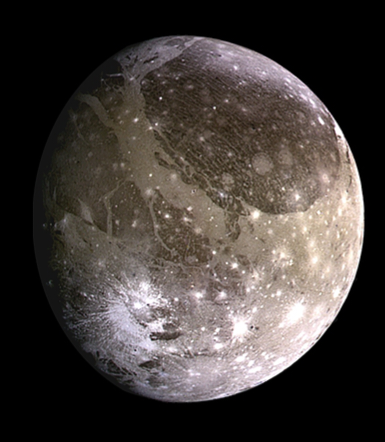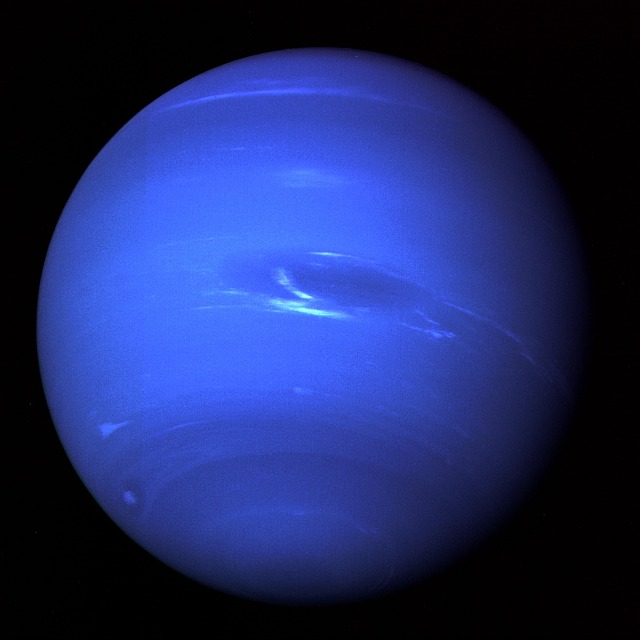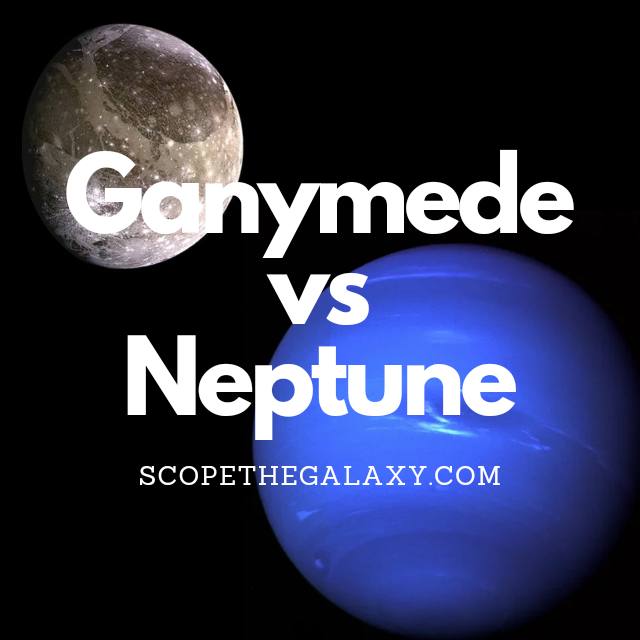*This post may contain affiliate links. This means we may make a commission if you purchase an item using one of our links*
The main differences between Ganymede and Neptune are that Neptune is an ice based gas giant whilst Ganymede is the largest moon in our solar system, Ganymede orbits Jupiter whilst Neptune only orbits the Sun, Neptune has the strongest winds in our solar system at 2,000 km/h and is nearly 10 times Ganymede’s size with a diameter of 49,244km compared to Ganymede’s 5,268km.
There are a variety of other features that separate the two so continue reading for a more detailed breakdown of both Ganymede and Neptune along with their similarities and differences.
What Is The Moon Ganymede?
Table of Contents

Ganymede is the largest of the Galilean moons – and the largest moon in our entire solar system – first discovered on 7th January 1610. The surface of this icy world is frozen and covered by two main types of landscape: young, light regions and old, crater-filled terrain. And these darker areas seem to contain a number of organic materials.
Using the Hubble Space Telescope, astronomers have found evidence of an oxygen-based atmosphere. Still, it is far too thin to support any living organisms that we know of. Based on this, it’s unlikely that Ganymede hosts life as we know it.
Estimates place Ganymede at around 4.5 billion years old (the same age as its planet, Jupiter), and its average distance from the Sun is approximately 778 million km.
Its diameter is 5,268km, making it larger than the planet Mercury. Despite this, Ganymede only possesses half the mass of Mercury at 1.48 × 10^23kg, so it is still classified as a low-density object.
Ganymede takes seven days to orbit its planet at an average distance of 665,00km, and the temperature varies from minus 112 to minus 193 degrees Celsius. In regards to the moon’s core temperature, that would be around 1,226 – 1,446 degrees Celsius.
Among the fascinating features of this ice moon is its magnetosphere. While many planets possess a magnetosphere, no other moon in our solar system shares this trait.
Measuring the changes in the magnetic fields of Ganymede and Jupiter allowed scientists to predict that salt water lies beneath the surface of this freezing world.
However, this is insufficient to support life when you factor in the other elements of this giant moon. In contrast to Europa, the rocky layer of Ganymede is not directly below the ocean, so life would have a difficult time forming both above and below the ice.
In addition, the thick layer of ice on the moon’s surface would make internal, water-based life challenging for scientists to detect.
What Is The Planet Neptune?

Neptune is the 8th farthest planet from the Sun and ranks among the bigger planets in our solar system. As the 8th farthest planet from the Sun, it does take Neptune a very long time to complete 1 orbital around the Sun.
This takes 165 years to complete which in comparison to the 16 hour 1 full spin around the axis is a massive difference.
In regards to its composition, Neptune is mostly made up of a thick swath of water closer to the center, methane, ammonia, hydrogen and helium molded around its Earth sized core.
As a result of the excess amount of methane and the inclusion of another undiscovered element within the atmosphere, Neptune’s color is a far deeper blue than the likes Uranus, which also has an abundantly methane based atmosphere.
The planet is 49,244km in diameter, making it roughly 4 times Earth’s diameter Earth, and would allow around 57 Earths to fit inside it. This also makes Neptune the 4th largest planet in our solar system.
Neptune is very cold mostly down to its distance from the Sun, where its atmospheric temperature sits between-220 to -230 degrees Celsius. Its core is far hotter coming in at 5,100 degrees Celsius and is the very likely cause for the liquid water present within the planet
Subsequently, the erratic temperature and gaseous composition of Neptune, is what constitute towards its turbulent behavior.
In fact Neptune has the fasted winds in our solar system, producing some that eclipse speeds of 2,000km per hour. The fastest winds on Earth would only be a fifth of these speeds at most.
At this moment in time we have discovered 14 moons orbiting Neptune and have also observed 5 thinner rings surrounding the ice giant.
Similarities Between Ganymede And Neptune
Neptune and Ganymede do share the odd few similar features, which in this case would include the following:
- Both are a spherical shape.
- Both have a hotter core.
- Both are part of the same solar system.
- Neither have tectonic plates.
- Both orbit another object.
- Both have a magnetosphere.
Differences Between Ganymede And Neptune
In regards to the differences between the two, they include the following:
- Neptune is the bigger of the two with a diameter of 49,244km compared to Ganymede’s diameter of 5,268km.
- Neptune has 14 moons whilst Ganymede has 0.
- Ganymede is a terrestrial based natural satellite whilst Neptune is a gas based ice giant.
- Ganymede orbits the Sun in 12 years and Jupiter in 7 day and 3 hours whilst Neptune completes an orbit around the Sun 165 years.
- Neptune orbits the Sun in an almost circular pattern whilst Ganymede orbits Jupiter in an elliptical pattern.
- Ganymede is tidally locked to Jupiter whilst Neptune is not tidally locked to anything.
- A day on Neptune is 16 hours whilst a day in Ganymede is 7 days and 3 hours.
- Neptune has 6 rings surrounding it whilst Ganymede has 0.
- Ganymede’s average temperature is between -112 to -193 degrees Celsius whilst Neptune’s temperature is between -220 to -230 degrees Celsius.
- In regards to core temperatures, Neptune’s is 5,100 degrees whilst Ganymede’s core temperature is between 1,226 -1,426 degrees Celsius.
- Ganymede has a mass of 1.48 × 10^23kg whereas Neptune has a mass of 1.024 × 10^26 kg.
- In regards gravitational strength Neptune’s is 11.15 m/s² whilst Ganymede’s gravitational strength is 1.428 m/s².
- Ganymede has a density of 1.94 g/cm³ whilst Neptune’s density is 1.64 g/cm³.
- As for their axial tilt, Ganymede’s is 0 – 0.33 degrees whilst Neptune’s axial tilt is 28 degrees.
- Neptune has the strongest winds amongst all the planets and much more than that on Ganymede at 2,000 km/h.
Summary
Neptune and Ganymede have a few similar features such as the fact both are part of the same solar system, have a magnetosphere and have no tectonic plates but, they’re definitely more different than similar.
Whether it be in regards to size, mass, their compositional structures and beyond so, all in all both are functionally very distinct and aren’t really in the same bracket of entity as a whole.

